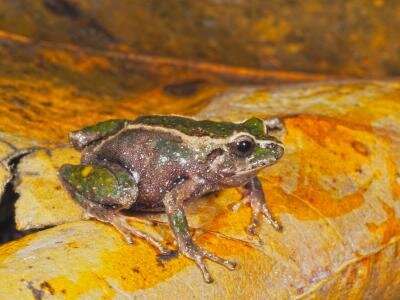New frog species discovered

UCF student Veronica Urgiles has helped describe two new frog species discovered in Ecuador, and she named one of them after one of her professors.
Urgiles and an international team of researchers just published their findings in the journal ZooKeys.
"Frogs are by far my favorite," said Urgiles, who is pursuing a master's degree in biology. "So, getting to describe and name two of them is terrific. I have been looking at these frogs for years now, so going over the whole process of observing them in their habitats and then analyzing them and comparing them under the microscope, to finally naming them is a long, but very satisfying journey."
Urgiles, a 2017 Fulbright scholar and the lead author, said she chose to attend UCF for its integration of genetics and genomics in biodiversity research and the emphasis on real-world application. She works with Assistant Professor Anna Savage who specializes in species diversity based on molecular analyses.
"One of the things that I found most interesting about these guys is that they don't have metamorphosis like a regular frog, but instead they develop entirely inside eggs that adult females deposit in the ground," Urgiles said. "They really don't need water bodies for their development. Both of the new frog species inhabit high elevation ecosystems in the mountain range over 8,000 feet, so even though we are right there in the equator, it's very cold and windy most of the year."
The team of researchers has been studying frogs in Ecuador the past few years. In 2017, Urgiles found the first new species and named it Pristimantis quintanai, after one of her biology professors—Pedro Quintana-Ascencio. She and Savage found the second species—Pristimantis cajanuma—in 2018. Both were found in the Paramo and montane forest of the southern Ecuadorean Andes.
The frogs are tiny, measuring .8 inch. Pristimantis quintanai females are brown and black and Pristimantis cajanuma are green and black, both easily blending into the foliage. They have a distinct call that is sharp and continuous, sounding like tik-tik-tik-tik.
Urgiles examined DNA samples collected by the international team back in Savage's lab at UCF, generated genetic sequences, and constructed the phylogenetic analysis. Other team members also worked the morphological diagnosis and comparisons with other frogs and an acoustic analysis of the frogs' calls.
"In these analyses, we use all of the genetic similarities and differences we find to build phylogenetic trees, and when we find that a 'branch' on the 'tree' has strong support and contains all of the individuals that share the same morphological characteristics, then we have good evidence to describe it as a new species," says Savage, whose expertise includes describing species diversity based on molecular analyses. "We used this method, along with vocalization and location data, to conclude that the two species we describe are distinct from any other species that have ever been characterized."
The work is critical because of the vast diversity that has yet to be discovered in the tropical Andes of South America, Urgiles says. In 2018, 13 new species of frogs were documented in the tropical Andes of Ecuador and so far in 2019 five new frogs have been documented.
There are potentially thousands of new plants and animals in the area that may hold the key to other discoveries. It's important to know what is there, to better understand the threats to habitat loss and disease so conservation methods can be established to protect the resources.
More information: Veronica L. Urgiles et al, Genetic delimitation of Pristimantis orestes (Lynch, 1979) and P. saturninoi Brito et al., 2017 and description of two new terrestrial frogs from the Pristimantis orestes species group (Anura, Strabomantidae), ZooKeys (2019). DOI: 10.3897/zookeys.864.35102
Journal information: ZooKeys
Provided by University of Central Florida




















